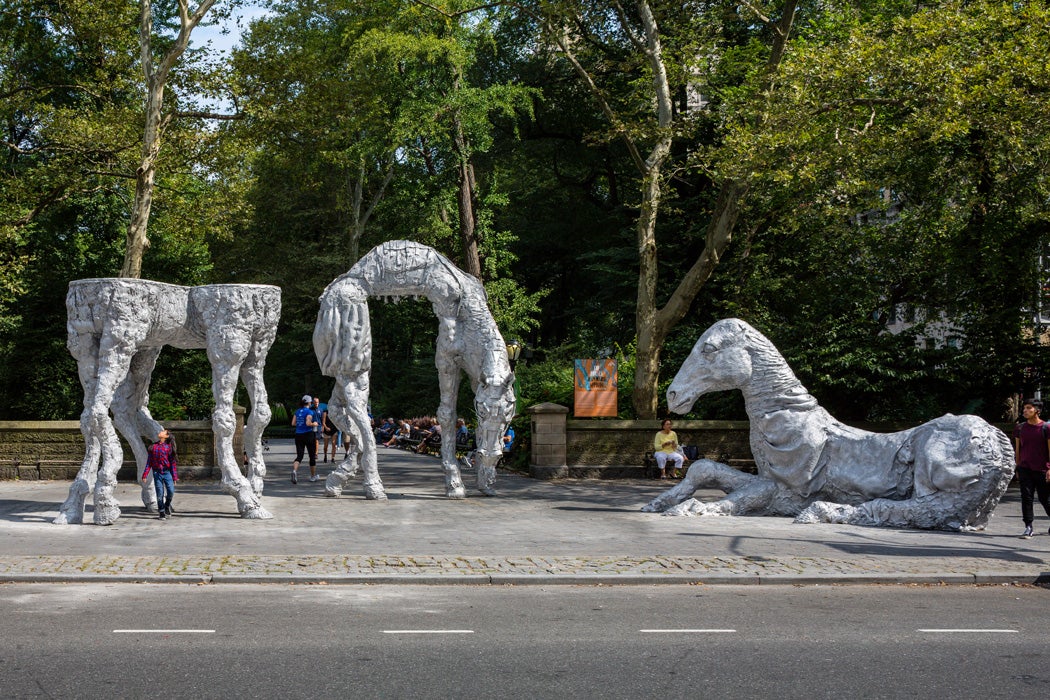City squares and parks around the world are packed with equestrian statues. From emperors and kings to generals and political leaders, a cavalcade of bronze riders stride through our public space. They are mostly men, except for a few rare depictions of queens, empresses, and Joan of Arc. It’s a commanding visual of action and power. And the style achieved its popularity thanks to one statue in Rome.
Most ancient Roman equestrian statues were melted down by the Catholic Church in the Middle Ages, but this influential example—a classical bronze of Emperor Marcus Aurelius dating to around 175 CE—survived due to a case of mistaken identity.
As art historian Helmut Nickel explains in the Metropolitan Museum Journal:
For centuries it stood in the Lateran [palace], until it was transferred, in 1538, to the Campidoglio [Capitoline Hill] by Michelangelo; it survived largely because it was erroneously believed to be an effigy of Constantine, the first Christian emperor. By a combination of this unjustified attribution, its own artistic merits, and its conspicuous presence, it served as a model for the majority of equestrian statues throughout the entire history of European art.
The equestrian statue of Marcus Aurelius stood in the open air of Rome until it was replaced with a copy in 1981. Over the centuries, its pose and dynamic presence inspired the way other rulers were portrayed. Notably, the larger-than-life Marcus Aurelius, who oversaw warfare in his reign, has his arm in the adlocutio salute that an emperor would give his troops, but he holds no weapons and has no military trappings. Shaping popular perception of benevolence and peace through statuary became just as essential as reinforcing power.

“During the Renaissance, the emperor’s gesture was susceptible to a number of interpretations,” art historian Michael P. Mezzatesta writes in The Art Bulletin. “One, closely related to the concept of Justice, was the granting of clemency, a view favored by the presence of a crouching barbarian (now lost) under the horse’s front leg.”
Marcus Aurelius was hardly the only Roman leader to be rendered on horseback, with this gesture, but he quickly became the most famous, owing to his prominent position in Rome. The influence spread across Europe during the Renaissance, when there was an increased interest in the art of the ancient world. “The equestrian statue raised in honor of Henri IV in 1614 was the first freestanding equestrian statue of a monarch situated in a public place in France,” historian Victoria E. Thompson writes in History and Memory. “It set a precedent that was followed throughout the seventeenth and eighteenth centuries, as statues of Henri IV, Louis XIII, Louis XIV and Louis XV became staples of every city of the kingdom.” And, as Thompson notes, that statue of Henri IV returning home from war, dressed in his armor, had its pose based on the Marcus Aurelius bronze.
Weekly Newsletter
Equestrian statues were a sign of cultural status. They were expensive and complicated to design, necessitating an artist to tackle both the human form and the movement of a horse. The imposing statues also physically and symbolically elevated a recent ruler to an ancient paragon. “The Philosopher Emperor, as he was popularly known, was to emerge during the Enlightenment as an appropriate public prototype for such diverse figures as the liberalizing despot Frederick the Great and a constitutional monarch such as George III,” architectural historian Arthur S. Marks explains in The American Art Journal. “Certainly by conjoining their images as in a statue, an ideal was created and it was hoped that a contemporary ruler so portrayed would metaphorically assume and actually aspire to the wisdom and grandeur of the ancient stoic leader and thinker.”
The tradition faded out as horses became obsolete in war. Still, the statues remain as formidable reminders of past powers, from Confederate leaders erected in the twentieth century as tools of oppression, to the 131-foot-tall Genghis Khan on horseback completed in 2008 in Mongolia. In the fall of 2019, artist Jean-Marie Appriou is installing several horse sculptures at the southern edge of New York City’s Central Park as a response to the nearby gilded equestrian statue of William Tecumseh Sherman. Centuries after he was immortalized in metal, the portrayal of Marcus Aurelius and the use of public statuary to forge a legacy endures around the world.







